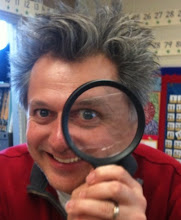Thursday, March 4, 2010
Super Hydrophobic Surfaces
The students last week started looking at super hydrophobic surfaces. We continued our investigations on levels of scale. Students categorized leaves based on their properties. On the macro scale kids sorted leaves based on color, texture, shape. After categorizing the leaves using the microscopes, they came up with some really amazing ways of categorizing the leaves. One group came up an interesting response I had not heard before. They grouped together leaves that all had a similar micro-structure that looked like a human tongue. Another group put all of the leaves together that seems to shine under magnification, or as one of the students said, “It looks like there are diamonds.” Finally, the students used water on the leaves to see if they had the nano-structures that would make its surface super hydrophobic. The first time I submerged a nasturtium leaf, the students gave a couple of wows. Then they were able to test the leaf surfaces of the leaves they had been using to test for super hydrophobicity. The poster by at NISE-Net is a great representation of scale. I also was able to share SEM images of the nasturtium leaf. The students were able to “see” what was happening on the nano scale.
Then, to represent through a model, I used a glove that is usually used to wash cars, to represent the nano sized “hairs.” Bubbles were used as a model of the water droplet, showing that because of the “hairs,” the water is not able to impregnate the surface of the leaf.
Dr. Neil Shirtcliffe from Nottingham Trent University used another model to demonstrate this using a bed of nails and a balloon. So, I tried it out with the students. I may need to modify my design a bit, but I think the students really liked it when we put the balloon on a single nail and got a nice loud pop.
This week’s investigation is about iridescence in nature and how light interacts with various surface structures.
Subscribe to:
Post Comments (Atom)



No comments:
Post a Comment